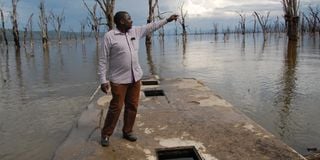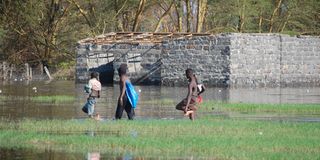Why Lake Nakuru water levels keep rising

A man points at Lake Nakuru on November 14, 2020. The water levels in the lake have risen in the recent past.
What you need to know:
- Scientists attribute the rising water levels in the lake to the effects of regional tectonics.
- The changing climate in the lake region is also a contributing factor to the rising lake levels.
Since 2012, the water levels in Lake Nakuru have been rising from an average of three metres to the highest level of approximately 8.5 metres recorded in April 2020.
The latest study conducted by experts from Nakuru County government has revealed that there has been a significant increase in lake area.
“The area lake has increased from 43 kilometer square in 2012 to the current 70 kilometer square by the end of April, consequently inundating about 26.6 kilometer square of the park area,” reads the report.
The 33-page report by Kiogora Murithi, Jackson Raini of FlamingoNet, Joseph Edebe of Kenya Wildlife Service and Ednah Waithaka of Kenya Marine, Fisheries and Research Institute in Naivasha further states that the lake depth is increasing from the shoreline to the middle part with a mean depth of 8.2meters.
Scientists attribute the rising water levels in the lake to the effects of regional tectonics influenced by the movements of the earth’s plate tectonics.
Tensional stress
“The tectonics create near field (a localised area affected by earth’s activities) and far field (an earth area that is far away) compressional and tensional stress fields. The near field stress regime or earth area will respond to the far field stress regime, but with a time lag. In our case, near field is the Rift Valley responding to the pull of the Indian Ocean which is a far field body,” said the report.
Other reasons advanced by the experts on the rising water levels are seasonal rainfall and evaporation which is translated into a strong lake level response, intensified land degradation which has resulted in higher rainfall run off leading to larger volume of water flowing directly into the lake.
The degradation of the lake’s riparian zones has decreased its depth through enhanced sediment.
“The lakes are rapidly becoming shallow while volumes of water flow into the lake and the volume retention remain the same, resulting into increase in the lake water levels,” added the report.
The changing climate in the lake region is also a contributing factor to the rising lake levels.
The lake is recharged by five lakes namely; Njoro, Makalia, Naishi, Larmudiak and groundwater and direct rainfall.
The rising lake levels is a blessing in disguise. It has resulted in significant change in the fish species diversity and abundance of tilapia species.
However, there has been a decline in the population of flamingos in the lake in the past eight years.
Heavy metals
The heavy metals analysis at the lake revealed that the concentration of zinc, lead, chromium, copper and cobalt among other metals were in small quantities.
The study shows that the heavy metals concentration in the two fish species were within the recommended Food Agriculture Organisation (FAO) and World Health Organization limit for fish and fish products.
However, the report puts a caveat on some fish species which exceeded the recommended limit of heavy metals due to pollution
“Chromium was detected in six of the eight fish samples exceeded FAO limit of 0.14mg/l, lead was detected in all the fish samples but remain within FAO standards. One sample of fish had nickel levels that exceeded the FAO limits of 0.14mg/L,” read the report.
The detection of heavy metals in the fish even in small concentration may not have immediate health threat in consumers but will likely have adverse effects if there is a prolonged consumption of the fish since heavy metals accumulate in the body.
Toxic metals
The report recommends several measures to save the lake including comprehensive monitoring of the water quality and fish, prevent discharge of toxic metals in the lake by enforcing county and national laws and regulations.

Barut residents walk past a submerged house due to the rising water levels at Lake Nakuru.
The report wants the county and national government to implement the Integrated Lake Basin Management, maintain sewerage treatment works and promote environment education. It also recommends storm water pollution control and installation of water treatment systems.
The development and utilisation of environmental management tools, technology and innovations should be stepped up while local communities should be encouraged to venture into fish farming.
The flooded zones of the lake in Barut area have been converted into fish eating zones.
“Although I’m not happy that some houses have been submerged, I’m elated that I’m selling fish to many customers and in a day I make between Sh1,500 and Sh2,000 which is good money,” said a fish trader in Barut area.





